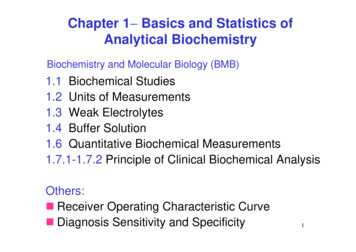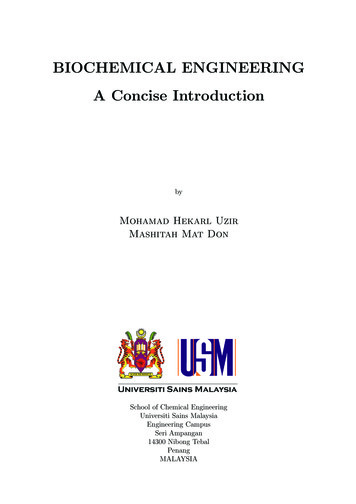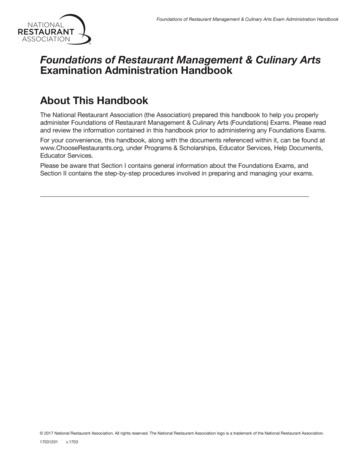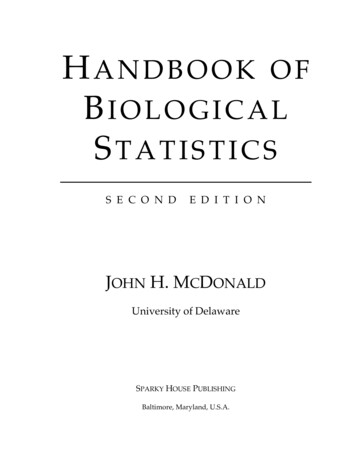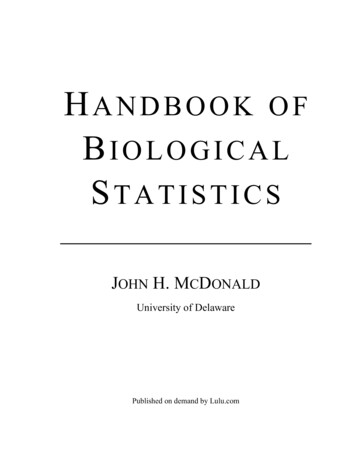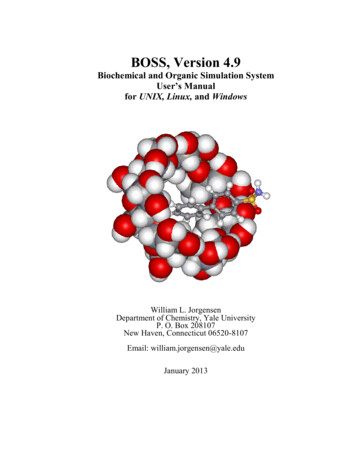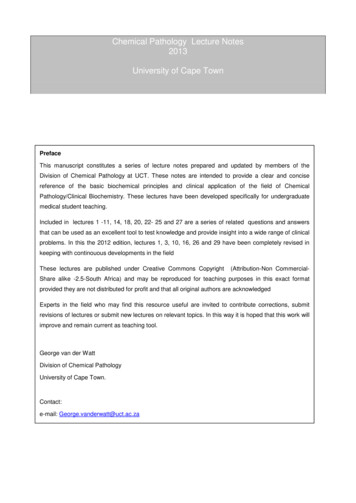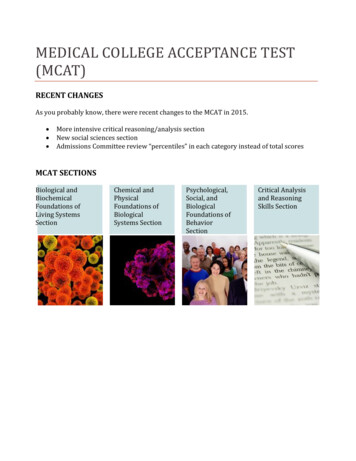
Transcription
What’s on the MCAT2015 Exam? Biological and Biochemical Foundations of Living SystemsWhat will the Biological and Biochemical Foundations of Living Systems Section Test?The Biological and Biochemical Foundations of Living Systems section asks you to solve problems bycombining your knowledge of biological and biochemical concepts with your scientific inquiry andreasoning skills. This section tests processes that are unique to living organisms, such as growing andreproducing, maintaining a constant internal environment, acquiring materials and energy, sensing andresponding to environmental changes, and adapting. It also tests how cells and organ systems within anorganism act independently and in concert to accomplish these processes, and it asks you to reasonabout these processes at various levels of biological organization within a living system.This section is designed to: test introductory-level biology, organic chemistry, and inorganic chemistry concepts;test biochemistry concepts at the level taught in many colleges and universities in first-semesterbiochemistry courses;test cellular and molecular biology topics at the level taught in many colleges and universities inintroductory biology sequences and first-semester biochemistry courses;test basic research methods and statistics concepts described by many baccalaureate faculty asimportant to success in introductory science courses; andrequire you to demonstrate your scientific inquiry and reasoning, research methods, and statisticsskills as applied to the natural sciences.Test SectionBiological and BiochemicalFoundations of Living SystemsNumber of Questions59(note that questions are acombination of passage-basedand discrete questions) 2015 AAMC. May not be reproduced without permission.Time95 minutes1
What’s on the MCAT2015 Exam? Biological and Biochemical Foundations of Living SystemsScientific Inquiry and Reasoning SkillsAs a reminder, the scientific inquiry and reasoning skills that you will be asked to demonstrate on thissection of the exam are:Knowledge of Scientific Concepts and Principles Demonstrating understanding of scientific concepts and principlesIdentifying the relationships between closely-related conceptsScientific Reasoning and Problem Solving Reasoning about scientific principles, theories, and modelsAnalyzing and evaluating scientific explanations and predictionsReasoning about the Design and Execution of Research Demonstrating understanding of important components of scientific researchReasoning about ethical issues in researchData-Based and Statistical Reasoning Interpreting patterns in data presented in tables, figures, and graphsReasoning about data and drawing conclusions from them 2015 AAMC. May not be reproduced without permission.2
What’s on the MCAT2015 Exam? Biological and Biochemical Foundations of Living SystemsGeneral Mathematical Concepts and TechniquesIt’s important for you to know that questions on the natural, behavioral, and social sciences sectionswill ask you to use certain mathematical concepts and techniques. As the descriptions of the scientificinquiry and reasoning skills suggest, some questions will ask you to analyze and manipulate scientificdata to show that you can Recognize and interpret linear, semilog, and log-log scales and calculate slopes from datafound in figures, graphs, and tables Demonstrate a general understanding of significant digits and the use of reasonable numericalestimates in performing measurements and calculations Use metric units, including converting units within the metric system and between metric andEnglish units (conversion factors will be provided when needed), and dimensional analysis(using units to balance equations) Perform arithmetic calculations involving the following: probability, proportion, ratio,percentage, and square-root estimations Demonstrate a general understanding (Algebra II level) of exponentials and logarithms(natural and base 10), scientific notation, and solving simultaneous equations Demonstrate a general understanding of the following trigonometric concepts: definitions ofbasic (sine, cosine, tangent) and inverse (sin‒1, cos‒1, tan‒1) functions; sin and cos values of 0 ,90 , and 180 ; relationships between the lengths of sides of right triangles containing angles of30 , 45 , and 60 Demonstrate a general understanding of vector addition and subtraction and the right-hand rule(knowledge of dot and cross products is not required)Note also that an understanding of calculus is not required, and a periodic table will be providedduring the exam. 2015 AAMC. May not be reproduced without permission.3
What’s on the MCAT2015 Exam? Biological and Biochemical Foundations of Living SystemsReferencesDuring the actual exam, you will have access to the periodic table below while answering questions inthis section of the exam. 2015 AAMC. May not be reproduced without permission.4
What’s on the MCAT2015 Exam? Biological and Biochemical Foundations of Living SystemsBiological and Biochemical Foundations of Living Systems Distribution of Questions byDiscipline, Foundational Concept, and Scientific Inquiry and Reasoning SkillYou may wonder how much biochemistry you’ll see on this section of the MCAT exam, how manyquestions you’ll get about a particular foundational concept, or how the scientific inquiry and reasoningskills will be distributed on your exam. The questions that you see are likely to be distributed in theways described below. These are the approximate percentages of questions you’ll see on a test for eachdiscipline, foundational concept, and scientific inquiry and reasoning skill.*Discipline: First-semester biochemistry, 25% Introductory biology, 65% General chemistry, 5% Organic chemistry, 5%Foundational Concept: Foundational Concept 1, 55% Foundational Concept 2, 20% Foundational Concept 3, 25%Scientific Inquiry and Reasoning Skill: Skill 1, 35% Skill 2, 45% Skill 3, 10% Skill 4, 10%*These percentages have been approximated to the nearest 5% and will vary from one test to another fora variety of reasons. These reasons include, but are not limited to, controlling for question difficulty,using groups of questions that depend on a single passage, and using unscored field-test questions oneach test form. 2015 AAMC. May not be reproduced without permission.5
What’s on the MCAT2015 Exam? Biological and Biochemical Foundations of Living SystemsBiological and Biochemical Foundations of Living Systems Framework of FoundationalConcepts and Content CategoriesFoundational Concept 1: Biomolecules have unique properties that determine how they contribute tothe structure and function of cells and how they participate in the processes necessary to maintain life.The content categories for this foundational concept include1A. Structure and function of proteins and their constituent amino acids1B. Transmission of genetic information from the gene to the protein1C. Transmission of heritable information from generation to generation and the processes thatincrease genetic diversity1D. Principles of bioenergetics and fuel molecule metabolismFoundational Concept 2: Highly-organized assemblies of molecules, cells, and organs interact tocarry out the functions of living organisms.The content categories for this foundational concept include2A. Assemblies of molecules, cells, and groups of cells within single cellular and multicellularorganisms2B. The structure, growth, physiology, and genetics of prokaryotes and viruses2C. Processes of cell division, differentiation, and specializationFoundational Concept 3: Complex systems of tissues and organs sense the internal and externalenvironments of multicellular organisms, and through integrated functioning, maintain a stableinternal environment within an ever-changing external environment.The content categories for this foundational concept include3A. Structure and functions of the nervous and endocrine systems and ways in which these systemscoordinate the organ systems3B. Structure and integrative functions of the main organ systems 2015 AAMC. May not be reproduced without permission.6
What’s on the MCAT2015 Exam? Biological and Biochemical Foundations of Living SystemsHow Foundational Concepts and Content Categories Fit TogetherThe MCAT exam asks you to solve problems by combining your knowledge of concepts with yourscientific inquiry and reasoning skills. Figure 1 illustrates how foundational concepts, contentcategories, and scientific inquiry and reasoning skills intersect to create test questions.Foundational Concept 1Foundational Concept yCategoryCategoryCategoryCategoryCategory1B1C2A at which foundational2B2C Each cell representsthe point1ASkill 1Skill 2Skill 3 concepts, content categories, and scientific inquiry andreasoning skills cross.Test questions are written at the intersections of theknowledge and skills.Skill 4 2015 AAMC. May not be reproduced without permission.7
What’s on the MCAT2015 Exam? Biological and Biochemical Foundations of Living SystemsUnderstanding the Foundational Concepts and Content Categories in the Biological andBiochemical Foundations of Living Systems SectionThe following are detailed explanations of each foundational concept and related content categories tested in theBiological and Biochemical Foundations of Living Systems section. To help you prepare for the MCAT exam, weprovide content lists that describe specific topics and subtopics that define each content category for this section.The same content lists are provided to the writers who develop the content of the exam. Here is an excerpt fromthe content list.EXCERPT FROM BIOLOGICAL AND BIOCHEMICAL FOUNDATIONS OF LIVING SYSTEMSOUTLINEMetabolism of Fatty Acids and Proteins (BIO, BC) TopicDescription of fatty acids (BC)SubtopicDigestion, mobilization, and transport of fatsOxidation of fatty acidso Saturated fatso Unsaturated fatsKetone bodies (BC)Anabolism of fats (BIO)Non-template synthesis: biosynthesis of lipids and polysaccharides (BIO)Metabolism of proteins (BIO)The abbreviations in parentheses indicate the courses in which undergraduate students at many colleges anduniversities learn about the topics and associated subtopics. The course abbreviations are BC: first-semester biochemistryBIO: two-semester sequence of introductory biologyGC: two-semester sequence of general chemistryOC: two-semester sequence of organic chemistryIn preparing for the MCAT exam, you will be responsible for learning the topics and associated subtopics at thelevels at which they are taught at many colleges and universities in the courses listed in parentheses. A smallnumber of subtopics have course abbreviations indicated in parentheses. In those cases, you are responsible onlyfor learning the subtopics as they are taught in the course(s) indicated.Using the excerpt above as an example, You are responsible for learning about the topic Metabolism of Fatty Acids and Proteins at the level atwhich it is taught in a typical two-semester introductory biology sequence and in a typical first-semesterbiochemistry course. You are responsible for learning about the subtopics Anabolism of fats, Non-template synthesis:biosynthesis of lipids and polysaccharides, and Metabolism of proteins only at the levels at which they aretaught in a typical two-semester sequence of introductory biology. You are responsible for learning about the subtopics Description of fatty acids and Ketone bodies only atthe levels at which they are taught in a typical first-semester biochemistry course. 2015 AAMC. May not be reproduced without permission.8
What’s on the MCAT2015 Exam? Biological and Biochemical Foundations of Living SystemsRemember that course content at your school may differ from course content at other colleges and universities.The topics and subtopics described in this and the next two chapters may be covered in courses with titles that aredifferent from those listed here. Your pre-health advisor and faculty are important resources for your questionsabout course content. 2015 AAMC. May not be reproduced without permission.9
What’s on the MCAT2015 Exam? Biological and Biochemical Foundations of Living SystemsBiological and Biochemical Foundations of Living SystemsFoundational Concept 1Biomolecules have unique properties that determine how they contribute to the structure andfunction of cells, and how they participate in the processes necessary to maintain life.The unique chemical and structural properties of biomolecules determine the roles they play in cells.The proper functioning of a living system depends on the many components acting harmoniously inresponse to a constantly changing environment. Biomolecules are constantly formed or degraded inresponse to the perceived needs of the organism.Content Categories Category 1A focuses on the structural and functional complexity of proteins, which is derivedfrom their component amino acids, the sequence in which the amino acids are covalently bonded,and the three-dimensional structures the proteins adopt in an aqueous environment. Category 1B focuses on the molecular mechanisms responsible for the transfer of sequencespecific biological information between biopolymers which ultimately results in the synthesis ofproteins. Category 1C focuses on the mechanisms that function to transmit the heritable informationstored in DNA from generation to generation. Category 1D focuses on the biomolecules and regulated pathways involved in harvestingchemical energy stored in fuel molecules, which serves as the driving force for all of theprocesses that take place within a living system.With these building blocks, medical students will be able to learn how the major biochemical,genetic, and molecular functions of the cell support health and lead disease. 2015 AAMC. May not be reproduced without permission.10
What’s on the MCAT2015 Exam? Biological and Biochemical Foundations of Living SystemsContent Category 1A: Structure and function of proteins and their constituent amino acidsMacromolecules formed from amino acids adopt well-defined, three-dimensional structures withchemical properties that are responsible for their participation in virtually every process occurring withinand between cells. The three-dimensional structure of proteins is a direct consequence of the nature ofthe covalently-bonded sequence of amino acids, their chemical and physical properties, and the way inwhich the whole assembly interacts with water.Enzymes are proteins that interact in highly regio- and stereo-specific ways with dissolved solutes. Theyeither facilitate the chemical transformation of these solutes, or allow for their transport innocuously.Dissolved solutes compete for protein-binding sites, and protein conformational dynamics give rise tomechanisms capable of controlling enzymatic activity.The infinite variability of potential amino acid sequences allows for adaptable responses to pathogenicorganisms and materials. The rigidity of some amino acid sequences makes them suitable for structuralroles in complex living systems.Content in this category covers a range of protein behaviors which originate from the unique chemistryof amino acids themselves. Amino acid classifications and protein structural elements are covered.Special emphasis is placed on enzyme catalysis, including mechanistic considerations, kinetics, modelsof enzyme-substrate interaction, and regulation. The topics and subtopics in this category are thefollowing:Amino Acids (BC, OC) Descriptiono Absolute configuration at the α positiono Amino acids as dipolar ionso Classifications Acidic or basic Hydrophobic or hydrophilicReactionso Sulfur linkage for cysteine and cystineo Peptide linkage: polypeptides and proteinso HydrolysisPlease NoteTopics that appear on multiple contentlists will be treated differently. Questionswill focus on the topics as they aredescribed in the narrative for the contentcategory.Protein Structure (BIO, BC, OC) Structureo 1 structure of proteinso 2 structure of proteinso 3 structure of proteins; role of proline, cystine, hydrophobic bondingo 4 structure of proteins (BIO, BC)Conformational stabilityo Denaturing and foldingo Hydrophobic interactionso Solvation layer (entropy) (BC)Separation techniqueso Isoelectric point 2015 AAMC. May not be reproduced without permission.11
What’s on the MCAT2015 Exam? Biological and Biochemical Foundations of Living SystemsoElectrophoresisNon-Enzymatic Protein Function (BIO, BC) Binding (BC)Immune systemMotorsEnzyme Structure and Function (BIO, BC) Function of enzymes in catalyzing biological reactionsEnzyme classification by reaction typeReduction of activation energySubstrates and enzyme specificityActive Site ModelInduced-fit ModelMechanism of catalysiso Cofactorso Coenzymeso Water-soluble vitaminsEffects of local conditions on enzyme activityControl of Enzyme Activity (BIO, BC) Kineticso General (catalysis)o Michaelis–Menteno CooperativityFeedback regulationInhibition – typeso Competitiveo Non-competitiveo Mixed (BC)o Uncompetitive (BC)Regulatory enzymeso Allosteric enzymeso Covalently-modified enzymeso Zymogen 2015 AAMC. May not be reproduced without permission.12
What’s on the MCAT2015 Exam? Biological and Biochemical Foundations of Living SystemsContent Category 1B: Transmission of genetic information from the gene to the proteinBiomolecules and biomolecular assemblies interact in specific, highly-regulated ways to transfersequence information between biopolymers in living organisms. By storing and transferring biologicalinformation, DNA and RNA enable living organisms to reproduce their complex components from onegeneration to the next. The nucleotide monomers of these biopolymers, being joined by phosphodiesterlinkages, form a polynucleotide molecule with a “backbone” composed of repeating sugar-phosphateunits and “appendages” of nitrogenous bases. The unique sequence of bases in each gene providesspecific information to the cell.DNA molecules are composed of two polynucleotides that spiral around an imaginary axis, forming adouble helix. The two polynucleotides are held together by hydrogen bonds between the paired basesand van der Waals interactions between the stacked bases. The pairing between the bases of twopolynucleotides is very specific, and its complementarity allows for a precise replication of the DNAmolecule.The DNA inherited by an organism leads to specific traits by dictating the synthesis of the biomolecules(RNA molecules and proteins) involved in protein synthesis. While every cell in a multicellularorganism inherits the same DNA, its expression is precisely regulated such that different genes areexpressed by cells at different stages of development, by cells in different tissues, and by cells exposedto different stimuli.The topics included in this category concern not only the molecular mechanisms of the transmission ofgenetic information from the gene to the protein (transcription and translation), but also thebiosynthesis of the important molecules and molecular assemblies that are involved in thesemechanisms. The control of gene expression in prokaryotes and eukaryotes is also included.Broadly speaking, the field of biotechnology uses biological systems, living organisms, or derivativesthereof, to make or modify products or processes for specific use. The biotechnological techniquesemphasized in this category, however, are those that take advantage of the complementary structure ofdouble-stranded DNA molecules to synthesize, sequence, and amplify them, and to analyze andidentify unknown polynucleotide sequences. Included within this treatment of biotechnology are thosepractical applications which directly impact humans, such as medical applications, human genetherapy, and pharmaceuticals.Content in this category covers the biopolymers, including ribonucleic acid (RNA), deoxyribonucleicacid (DNA), proteins, and the biochemical processes involved in carrying out the transfer of biologicalinformation from DNA. The topics and subtopics in this category are the following:Nucleic Acid Structure and Function (BIO, BC) DescriptionNucleotides and nucleosideso Sugar phosphate backboneo Pyrimidine, purine residuesDeoxyribonucleic acid (DNA): double helix, Watson–Crick model of DNA structureBase pairing specificity: A with T, G with CFunction in transmission of genetic information (BIO) 2015 AAMC. May not be reproduced without permission.13
What’s on the MCAT2015 Exam? Biological and Biochemical Foundations of Living Systems DNA denaturation, reannealing, hybridizationDNA Replication (BIO) Mechanism of replication: separation of strands, specific coupling of free nucleic acidsSemi-conservative nature of replicationSpecific enzymes involved in replicationOrigins of replication, multiple origins in eukaryotesReplicating the ends of DNA moleculesRepair of DNA (BIO) Repair during replicationRepair of mutationsGenetic Code (BIO) Central Dogma: DNA RNA proteinThe triplet codeCodon–anticodon relationshipDegenerate code, wobble pairingMissense, nonsense codonsInitiation, termination codonsMessenger RNA (mRNA)Transcription (BIO) Transfer RNA (tRNA); ribosomal RNA (rRNA)Mechanism of transcriptionmRNA processing in eukaryotes, introns, exonsRibozymes, spliceosomes, small nuclear ribonucleoproteins (snRNPs), small nuclear RNAs(snRNAs)Functional and evolutionary importance of intronsTranslation (BIO) Roles of mRNA, tRNA, rRNARole and structure of ribosomesInitiation, termination co-factorsPost-translational modification of proteinsEukaryotic Chromosome Organization (BIO) Chromosomal proteinsSingle copy vs. repetitive DNASupercoilingHeterochromatin vs. euchromatinTelomeres, centromeresControl of Gene Expression in Prokaryotes (BIO) Operon Concept, Jacob–Monod Model 2015 AAMC. May not be reproduced without permission.14
What’s on the MCAT2015 Exam? Biological and Biochemical Foundations of Living Systems Gene repression in bacteriaPositive control in bacteriaControl of Gene Expression in Eukaryotes (BIO) Transcriptional regulation DNA binding proteins, transcription factors Gene amplification and duplication Post-transcriptional control, basic concept of splicing (introns, exons) Cancer as a failure of normal cellular controls, oncogenes, tumor suppressor genes Regulation of chromatin structure DNA methylation Role of non-coding RNAsRecombinant DNA and Biotechnology (BIO) Gene cloning Restriction enzymes DNA libraries Generation of cDNA Hybridization Expressing cloned genes Polymerase chain reaction Gel electrophoresis and Southern blotting DNA sequencing Analyzing gene expression Determining gene function Stem cells Practical applications of DNA technology: medical applications, human gene therapy, pharmaceuticals, forensic evidence, environmental cleanup, agricultureSafety and ethics of DNA technology 2015 AAMC. May not be reproduced without permission.15
What’s on the MCAT2015 Exam? Biological and Biochemical Foundations of Living SystemsContent Category 1C: Transmission of heritable information from generation to generationand the processes that increase genetic diversityThe information necessary to direct life functions is contained within discrete nucleotide sequencestransmitted from generation to generation by mechanisms that, by nature of their various processes,provide the raw materials for evolution by increasing genetic diversity. Specific sequences ofdeoxyribonucleic acids store and transfer the heritable information necessary for the continuation of lifefrom one generation to the next. These sequences, called genes ― being part of longer DNA molecules― are organized, along with various proteins, into biomolecular assemblies called chromosomes.Chromosomes pass from parents to offspring in sexually-reproducing organisms. The processes ofmeiosis and fertilization maintain a species’ chromosome count during the sexual life cycle. Becauseparents pass on discrete heritable units that retain their separate identities in offspring, the laws ofprobability can be used to predict the outcome of some, but not all, genetic crosses.The behavior of chromosomes during meiosis and fertilization is responsible for most of the geneticvariation that arises each generation. Mechanisms that contribute to this genetic variation includeindependent assortment of chromosomes, crossing over, and random fertilization. Other mechanisms,such as mutation, random genetic drift, bottlenecks, and immigration, exist with the potential to affectthe genetic diversity of individuals and populations. Collectively, the genetic diversity that results fromthese processes provides the raw material for evolution by natural selection.The content in this category covers the mechanisms by which heritable information is transmitted fromgeneration to generation, and the evolutionary processes that generate and act upon genetic variation.The topics and subtopics in this category are the following:Evidence that DNA is Genetic Material (BIO)Mendelian Concepts (BIO) Phenotype and genotypeGeneLocusAllele: single and multipleHomozygosity and heterozygosityWild-typeRecessivenessComplete dominanceCo-dominanceIncomplete dominance, leakage, penetrance, expressivityHybridization: viabilityGene poolMeiosis and Other Factors Affecting Genetic Variability (BIO) Significance of meiosis 2015 AAMC. May not be reproduced without permission.16
What’s on the MCAT2015 Exam? Biological and Biochemical Foundations of Living Systems Important differences between meiosis and mitosisSegregation of geneso Independent assortmento Linkageo Recombinationo Single crossoverso Double crossoverso Synaptonemal complexo Tetrado Sex-linked characteristicso Very few genes on Y chromosomeo Sex determinationo Cytoplasmic/extranuclear inheritanceMutationo General concept of mutation — error in DNA sequenceo Types of mutations: random, translation error, transcription error, base substitution,inversion, addition, deletion, translocation, mispairingo Advantageous vs. deleterious mutationo Inborn errors of metabolismo Relationship of mutagens to carcinogensGenetic driftSynapsis or crossing-over mechanism for increasing genetic diversityAnalytic Methods (BIO) Hardy–Weinberg PrincipleTestcross (Backcross; concepts of parental, F1, and F2 generations)Gene mapping: crossover frequenciesBiometry: statistical methodsEvolution (BIO) Natural selectiono Fitness concepto Selection by differential reproductiono Concepts of natural and group selectiono Evolutionary success as increase in percent representation in the gene pool of the nextgenerationSpeciationo Polymorphismo Adaptation and specializationo Inbreedingo Outbreedingo BottlenecksEvolutionary time as measured by gradual random changes in genome 2015 AAMC. May not be reproduced without permission.17
What’s on the MCAT2015 Exam? Biological and Biochemical Foundations of Living SystemsContent Category 1D: Principles of bioenergetics and fuel molecule metabolismLiving things harness energy from fuel molecules in a controlled manner in order to sustain all of theprocesses responsible for maintaining life. Cell maintenance and growth is energetically costly. Cellsharness the energy stored in fuel molecules, such as carbohydrates and fatty acids, and convert it intosmaller units of chemical potential known as adenosine triphosphate (ATP).The hydrolysis of ATP provides a ready source of energy for cells that can be coupled to other chemicalprocesses in order to make them thermodynamically favorable. Fuel molecule mobilization, transport,and storage are regulated according to the needs of the organism.The content in this category covers the principles of bioenergetics and fuel molecule catabolism. Detailsof oxidative phosphorylation including the role of chemiosmotic coupling and biological electrontransfer reactions are covered, as are the general features of fatty acid and glucose metabolism.Additionally, regulation of these metabolic pathways, fuel molecule mobilization, transport, and storageare covered. The topics and subtopics in this category are the following:Principles of Bioenergetics (BC, GC) Bioenergetics/thermodynamicso Free energy/K eq Equilibrium constant Relationship of the equilibrium constant and ΔG o Concentration Le Châtelier’s Principleo Endothermic/exothermic reactionso Free energy: Go Spontaneous reactions and ΔG Phosphoryl group transfers and ATPo ATP hydrolysis ΔG 0o ATP group transfersBiological oxidation-reductiono Half-reactionso Soluble electron carrierso FlavoproteinsCarbohydrates (BC, OC) Descriptiono Nomenclature and classification, common nameso Absolute configurationo Cyclic structure and conformations of hexoseso Epimers and anomersHydrolysis of the glycoside linkageMonosaccharidesDisaccharidesPolysaccharides 2015 AAMC. May not be reproduced without permission.18
What’s on the MCAT2015 Exam? Biological and Biochemical Foundations of Living SystemsGlycolysis, Gluconeogenesis, and the Pentose Phosphate Pathway (BIO, BC) Glycolysis (aerobic), substrates and productso Feeder pathways: glycogen, starch metabolismFermentation (anaerobic glycolysis)Gluconeogenesis (BC)Pentose phosphate pathway (BC)Net molecular and energetic results of respiration processesPrinciples of Metabolic Regulation (BC) Regulation of metabolic pathways (BIO, BC)o Maintenance of a dynamic steady stateRegulation of glycolysis and gluconeogenesisMetabolism of glycogenRegulation of glycogen synthesis and breakdowno Allosteric and hormonal controlAnalysis of metabolic controlCitric Acid Cycle (BIO, BC) Acetyl-CoA production (BC)Reactions of the cycle, substrates and productsRegulation of the cycleNet molecular and energetic results of respiration processesMetabolism of Fatty Acids and Proteins (BIO, BC) Des
The MCAT exam asks you to solve problems by combining your knowledge of concepts with your scientific inquiry and reasoning skills. Figure 1 illustrates how foundational concepts, content categories, and scientific inquiry and reasoning skills intersect to create test questions. Foundational Concept 1 Foundational Concept 2 . Content Category 1A
